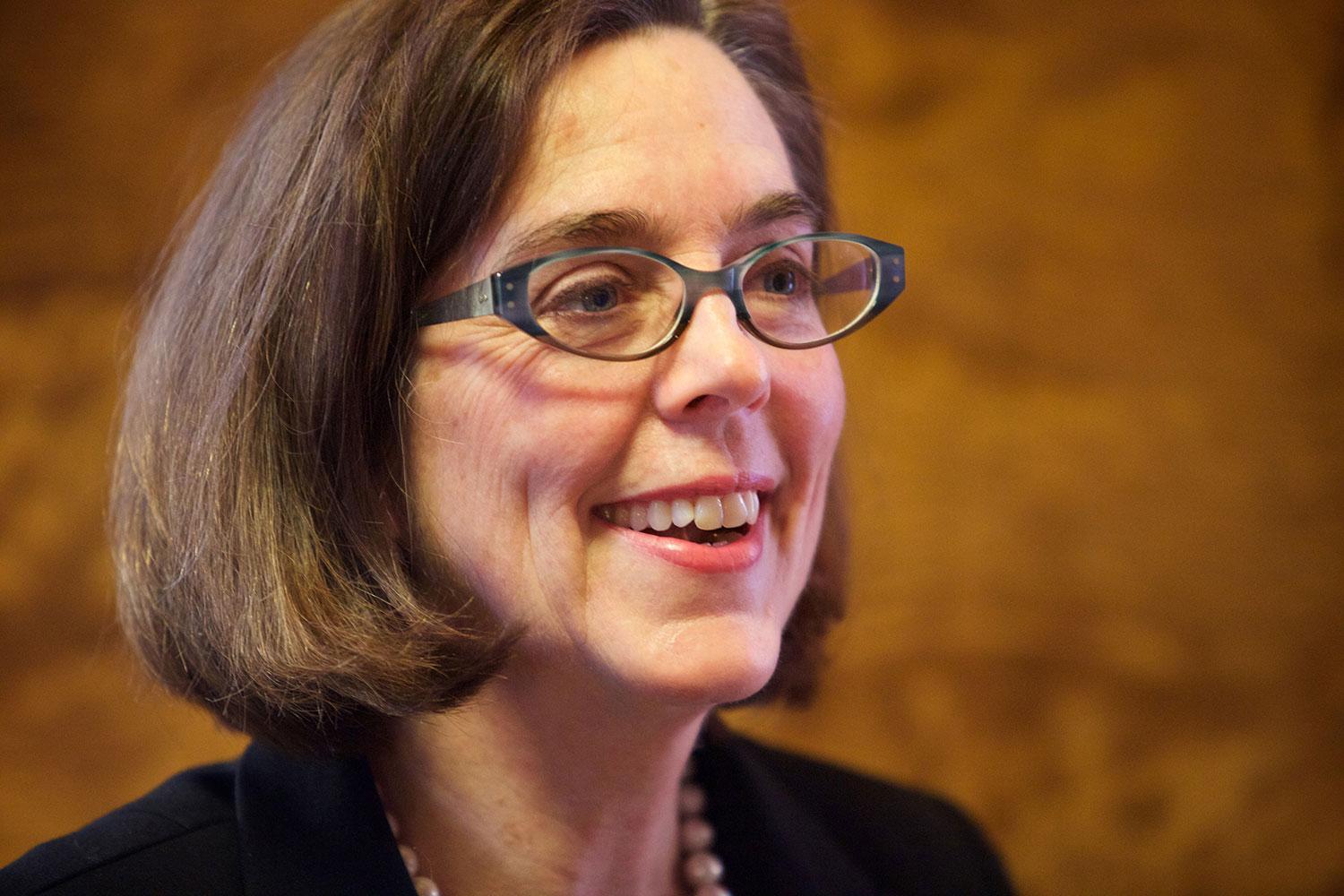
The Governor

Oregon’s new leader, Kate Brown, takes charge.
Kate Brown (EnvCon’81) has climbed the ranks in Oregon politics for more than 25 years. In February 2015, she made it to the top.
The 56-year-old Democrat took the oath of office as Oregon’s 38th governor on Feb. 18, following the resignation, days earlier, of predecessor John Kitzhaber, who became embroiled in controversy about his fiancée’s consulting work. As secretary of state, Brown was next in succession. She joins the ranks of other Buff governors, a group that includes former Colorado leaders Roy Romer (Law’52, HonDocHum’06) and Bill Ritter (Law’81).
With Brown’s elevation to Oregon’s top public office, details about her personal life made headlines across the nation. Americans learned the Minnesota native likes yoga, cycling and horseback riding, has been married to her husband for 18 years — and identifies as bisexual. She has been widely described as the nation’s first openly LGBT governor.
“For those of us who know her, it didn’t make much of a difference,” says Brown’s mentor, Barbara Roberts, Oregon’s first female governor, who served from 1991-95. Brown, she says, had been open about who she is for years.
The new governor quickly made it clear she intends to be recognized for her accomplishments in office, not her personal life.
Kate clearly had the personality, energy and intellect. She was not just a likeable person. She was very articulate about the causes she represented.
Within a month of her inauguration, she signed a voter registration bill she had introduced as secretary of state. It made Oregon the first state in the nation to automatically register all eligible citizens to vote, and was expected to add about 300,000 new voters in the near-term, according to Tony Green, communications director in the Oregon secretary of state’s office.
Brown’s move won a favorable nod from MSNBC host Rachel Maddow, who said in March, “The state of Oregon will now become the first state in the country where it is easier to be registered than not …This is groundbreaking.”
Concerned about government transparency after the Kitzhaber scandal, Brown confronted the issue directly in her inaugural address: “The people of Oregon have had reason to question their trust in state government… It’s time for us to get back to work. It’s time to move Oregon forward.”
Says Roberts, “This was a difficult way to step into the governor’s office. She very quickly prioritized what needed to be done.”
Kate Brown became Oregon’s governor Feb. 18, after her predecessor resigned amid scandal. She previously served as the secretary of state.
Restoring public trust in state government may be a difficult task for Brown, especially since she is from the same party as Kitzhaber, says Jeff Harden, an assistant professor of political science at CU-Boulder who specializes in American state politics. But because she wasn’t part of Kitzhaber’s administration, she has more opportunity to distance herself from his actions in office, he says.
“A key challenge she will face is proving to voters she won’t just be more of the same and that her tenure will be productive,” he says. “The more she is in the news for success in the policy arena, the better.”
Brown has years of legislative experience to draw upon. After her graduation from CU-Boulder with a degree in environmental conservation, Brown earned a law degree from Lewis & Clark College in Portland, Ore., and practiced family and juvenile law. She served five years in the Oregon House of Representatives and 12 years in the Oregon Senate, where she was chosen as Oregon’s first female Senate majority leader in 2004.
“Kate clearly had the personality, energy and intellect to do a solid job in the legislature,” says Roberts. “She was not just a likeable person. She was very articulate about the causes she represented.”
Roberts, 78, and Brown met three decades ago, when Brown was a young lobbyist for women’s rights. The pair grew close as their careers began to overlap. In recent years, Brown often drove Roberts, who is widowed, from Portland to political events in Salem, the state capital. Along the way, Brown would seek career advice. Roberts encouraged her to run for secretary of state.
“It’s amazing how much you can accomplish in the car,” Roberts says.
Brown was elected secretary of state in 2008 and re-elected in 2012. In office she focused on improving voter registration, simplifying the process for establishing businesses and making election campaign contributions more transparent.She has a little less than two years to make her mark. If she wants to complete Kitzhaber’s term, she would need to enter primary and general election contests in 2016.
Brown, the second female governor of Oregon, is only the fourth woman in the U.S. to become governor after a political scandal, Harden says, and two of the women ran for full terms — Jane Dee Hull of Arizona and Jodi Rell of Connecticut. Both were elected.
“If she can demonstrate the ability to step in and lead during a critical time, she will likely have strong election prospects,” Harden says. “Positive action now can benefit her more than promises in a campaign ad.”
In the meantime, she is adjusting to life as governor. In March she and her husband moved into the state’s 91-year-old governor’s residence in Salem.
She’s also keeping her mentor, Roberts, close: Prior to the memorial service for former attorney general Dave Frohnmayer this spring, Roberts received a call from Brown’s office, asking if she wanted to carpool.
Photography by Michael Lloyd/The Oregonian (portrait); Bruce Ely/The Oregonian (becoming Governor)

